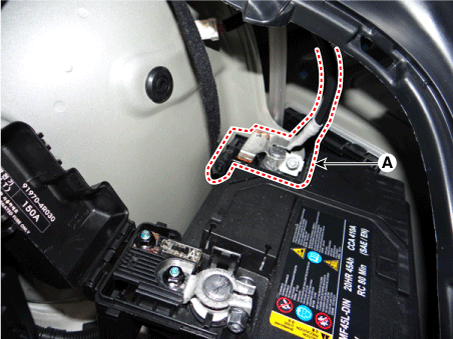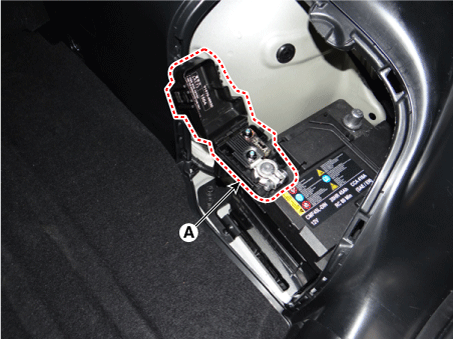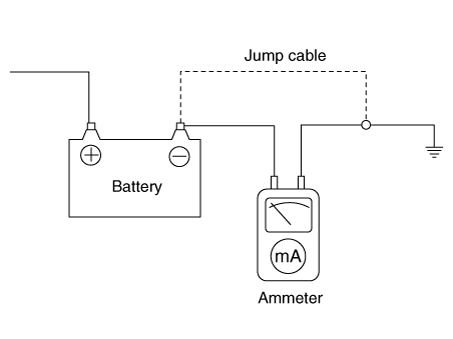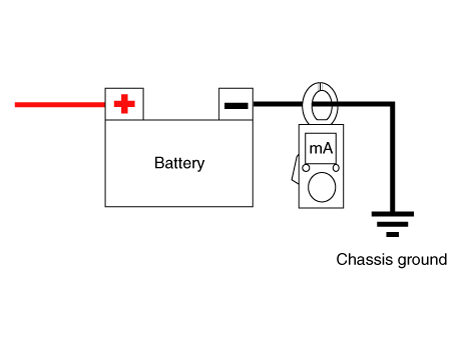Kia Niro: Power Train / Battery Repair procedures
Battery Voltage and
Status
Check the battery voltage and status using the battery tester.
Battery Terminal
| 1. |
Move back and forth to check that the battery terminals (A) are loose
or corroded.If the terminals are corroded, clean them.


If battery positive connection is loose, disconnect ground(GND) cable
first before attempting to remove or tighten plus connection, to prevent
personal injury.
|
| 2. |
If the battery clamp on battery positive (+) terminal is not seated securely:
| (1) |
Turn ignition switch OFF and disconnect the battery negative
(-) terminal.
|
| (2) |
Tighten battery clamp (A) on battery positive (+) terminal
|
Battery positive (+) terminal tightening nut :
7.8 - 9.8 N·m (0.8 - 1.0 kgf·m, 5.8 - 7.2 lb·ft)
|

|
|
| 3. |
If the battery clamp on battery negative (-) terminal is not seated securely:
| (1) |
Tighten battery clamp (A) on battery negative (-) terminal.
|
Battery negative (-) terminal tightening nut :
7.8 - 9.8 N·m (0.8 - 1.0 kgf·m, 5.8 - 7.2 lb·ft)
|

|
|
Battery Condition
Check the battery for damage or deformation. If severe damage, deformation or
leakage is found, replace the battery.
Vehicle parasitic current
inspection
[Using the Ammeter]
| 1. |
Turn the all electric devices OFF, and then turn the ignition switch
OFF.
|
| 2. |
Close all doors except the engine hood, and then lock all doors.
| (1) |
Disconnect the hood switch connector.
|
| (3) |
Close the doors or remove the door switches.
|
|
| 3. |
Wait a few minutes until the vehicle’s electrical systems go to sleep
mode.
| •
|
For an accurate measurement of a vehicle parasitic current,
all electrical systems should go to sleep mode. (It takes
at least one hour or at most one day.) However, an approximate
vehicle parasitic current can be measured after 10-20 minutes.
|
|
|
| 4. |
Connect an ammeter in series between the battery (-) terminal and the
ground cable, and then disconnect the clamp from the battery (-) terminal
slowly.
| •
|
Be careful that the lead wires of an ammeter do not come
off from the battery (-) terminal and the ground cable to
prevent the battery from being reset. In case the battery
is reset, connect the battery cable again, and then start
the engine or turn the ignition switch ON for more than
10 sec. Repeat the procedure from No. 1.
To prevent the battery from being reset during the inspection,
|
| 1) |
Connect a jump cable between the battery (-) terminal
and the ground cable.
|
| 2) |
Disconnect the ground cable from the battery (-) terminal.
|
| 3) |
Connect an ammeter between the battery (-) terminal and
the ground cable.
|
| 4) |
After disconnecting the jump cable, read the current
value of the ammeter.
|
|

|
| 5. |
Read the current value of the ammeter.
| • |
If the parasitic current is over the limit value, search for
abnormal circuit by removing a fuse one by one and checking the
parasitic current.
|
| • |
Reconnect the suspected parasitic currentdraw circuit fuse only
and search for suspectedunit by removing the component connected
with thecircuit one by one until the parasitic draw dropsbelow limit
value.
|
|
Limit value (after 10-20 min.) : Below 50mA
|
|
[Using the Clamp type Ammeter]
| 1. |
Turn the all electric devices OFF, and then turn the ignition switch
OFF.
|
| 2. |
Close all doors except the engine hood, and then lock all doors.
| (1) |
Disconnect the hood switch connector.
|
| (3) |
Close the doors or remove the door switches.
|
|
| 3. |
Wait a few minutes until the vehicle’s electrical systems go to sleep
mode.
| •
|
For an accurate measurement of a vehicle parasitic current,
all electrical systems should go to sleep mode. (It takes
at least one hour or at most one day.) However, an approximate
vehicle parasitic current can be measured after 10 - 20
minutes.
|
|
|
| 4. |
Install the clamp type ammerter on battery negative (-) terminal.

|
| 5. |
Read the current value of the ammeter.
| • |
If the parasitic current is over the limit value, search for
abnormal circuit by removing a fuse one by one and checking the
parasitic current.
|
| • |
Reconnect the suspected parasitic currentdraw circuit fuse only
and search for suspectedunit by removing the component connected
with thecircuit one by one until the parasitic draw dropsbelow limit
value.
|
|
Limit value (after 10-20 min.) : Below 50mA
|
|
Inspection
1.
Remove the air cleaner element.
2.
Check that the air filter is excessively dirty.
If the air filter is excessively dirty, repla ...
Inspection
Radiator hoses
1.
Check radiator hoses for the following
(1)
Improper attachment
(2)
Leaks ...
 Air Cleaner Filter Repair procedures
Air Cleaner Filter Repair procedures Cooling System Repair procedures
Cooling System Repair procedures




